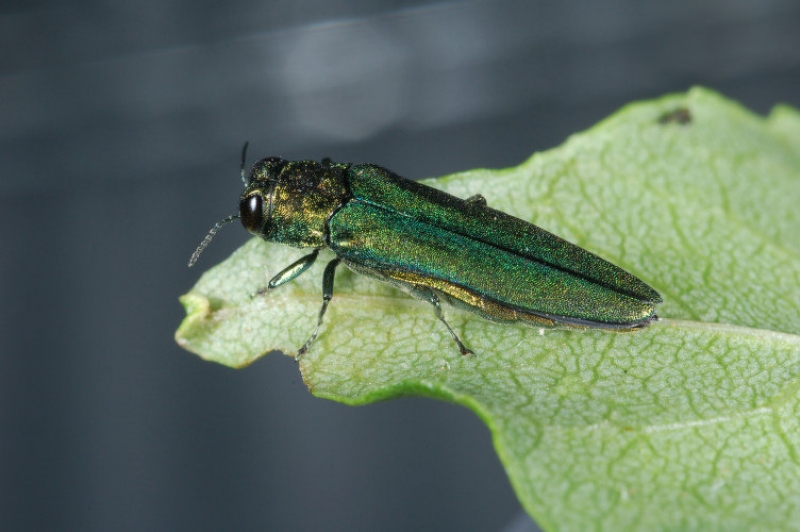
An emerald ash borer beetle on a leaf. Photo: Flickr Creative Commons, USDA
Run, Dorothy—Emerald City is Falling
Watertown is poised to become an Emerald City, but that’s not good news. Jefferson and Lewis will soon be Emerald Counties, and St. Lawrence County began the process of change two years ago. Unfortunately, this kind of transformation does not involve happy endings.
When the emerald ash borer (EAB) kills an ash, something happens never before seen—the tree becomes brittle and hazardous very quickly, beyond anything in our experience in North America prior to this. Municipal leaders, DOT officials, woodlot owners, loggers, farmers and other land managers need to be well-informed in order to stay safe and avoid liability.
Call it an infection or an epidemic, but soon even the most pleasant tree-lined street and well-managed woodlot will seem like something out of Tolkein’s menacing Fangorn Forest in his Lord of the Rings trilogy. Our ash trees won’t turn vengeful, but they will be dangerous for other reasons.
In August 2017, citizen volunteers trained by the New York State Department of Environmental Conservation (NYSDEC) discovered emerald ash borer in an EAB trap in the St. Lawrence County township of Hammond, and later the same year, a large infestation was found near Massena. Foresters from the St. Regis Mohawk Tribal Environment Division also confirmed several EAB in Franklin County in 2017.
Early this summer, volunteers trapped EAB in other NY locations, including on the southern Jefferson County border. The NYSDEC has not yet released final data from 2018’s trap program, but we do expect confirmations in more areas. Understandably, we may be tired of hearing about this invasive wood-boring beetle and how it will wipe out ash trees. After all, chestnuts and elms died and the world didn’t end. The difference is in the degree of hazard posed.
Usually when a healthy tree is killed by a pest, disease or flood, it stands there 5, 10 or more years. If you don’t show up within 15 years, it shrugs, mumbles something about your lack of work ethic, and topples over. Think of all the dead trees in beaver ponds that stand for a decade or more as herons nest in their bleached crowns. After the chestnut blight wiped out that species, there were reports of the dead snags remaining upright for 30 or more years.
But the emerald ash borer has a peculiar effect on the ash trees it kills. Ash that succumb to EAB become dangerous in as little as one year, and after only two years, they start leaping onto cars, trucks and busloads of schoolkids. That is taking it a little too far, but many people have been injured, and many homes and vehicles damaged in the wake of EAB infestations. In Ohio, a school bus was hit by a large EAB-killed ash tree, injuring 5 students and the driver, and pretty well totaling the bus.
No one seems to have an adequate explanation for this rapid and profound loss of wood strength, but I’ll pass along what we do know. According to the Davey Resource Group, the consulting and research branch of Davey Tree, the shear-strength of ash wood undergoes a five-fold decrease after the tree is infested by EAB. Trees become dangerous so quickly that Davey Tree will not allow its climbers into any infested ash that shows a 20% decline or more.
In the words of Mike Chenail, an International Society of Arboriculture Certified Arborist from Pennsylvania, “Two realities make an ash tree killed by EAB especially dangerous. EAB cuts off the flow of water and nutrients through the tree. Additionally, the fatal pest creates thousands of exit wounds. Both conspire to dry out the tree and make it brittle.”
One of the issues is that the sapwood, the outermost layer of wood, dries very rapidly. Since sapwood may only be a few inches thick, having it suddenly dry out may not seem like much. Jerry Bond, a Consulting Urban Forester and former Cornell Extension Educator, explained it to me this way: “Ninety percent of the structural strength of a tree resides in the outermost ten percent of the trunk.” In other words, when sapwood is weakened, there’s not much strength left in the tree.
There may be yet another facet to the picture. Anecdotes from arborists and other tree workers point to the surprisingly advanced decay in some ash wood that had only been infested one season. How widespread or significant this may be is not yet known.
But none of that is really the point. The point is that those who work or spend much time in the woods, and anyone responsible for the safety of others need to be aware that when EAB kills ash trees, they behave differently.
Woodlot owners, Town and Village Supervisors, Town Board members, NNY County Legislators, and others who want to learn how to prepare for EAB are urged to attend an upcoming EAB informational session at the Adams Municipal Building, 3 South Main Street, Adams, NY on Wednesday, November 14, 2018 from 8:30 AM to 12:00 PM. Presenters include representatives from NYSDEC, National Grid and others. The session is free, but please RSVP to Mike Giocondo in the NYSDEC Lowville sub-office at (315) 376-3521 or michael.giocondo@dec.ny.gov
For more info on EAB in the North Country, visit Nature Up North's Emerald Ash Borer web page.

